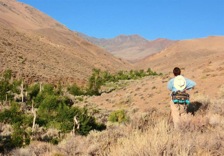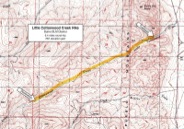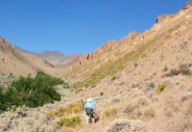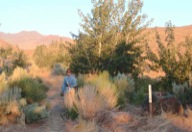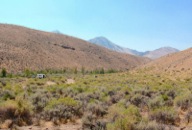Less Traveled Northwest
Day Hikes for the Adventurous
Little Cottonwood Creek Hike
Hike Rating: Moderate
Hike Length: 6.4 miles roundtrip (variable)
Elevation Gain: 760’
Trailhead Elevation: 4,340’
Best Season: June through September
Driving Access: Any vehicle, with care
Plus Points
• A scenic, low-elevation stream canyon in a dry landscape with colorful rock formations
• Little Cottonwood Creek is within a BLM Wilderness Study Area
• Perennial water in the canyon supports small cottonwood trees and abundant wildlife
• Look for short-eared owls and mule deer in the streamside cottonwood thickets
• Abundant songbirds, including chickadees, towhees, wrens, flycatchers and warblers
• No sign of cow activity in the canyon and solitude is almost assured here
Minus Points
• No established hiking trail, but walking is easy along numerous game trails
• Rattlesnakes are a possibility throughout the summer, so caution is advised
• Hike can be hot in midsummer, so plan to start in the early AM and return by noon
Download (PDF, 603 KB): Photos of Little Cottonwood Creek Hike
Download (PDF, 793 KB): Topo Map for Little Cottonwood Creek Hike
Download (PDF, 546 KB): Road Map for Little Cottonwood Creek Hike
Trail Notes
The trail starts at the end of the access road up Little Cottonwood Creek at the "Wilderness Study Area" marker. The hike follows a faint double-track jeep road west through big sagebrush on the north side of the creek for about a quarter mile to a deep gulch, where the road turns north uphill. Rather than follow the road, the route crosses the gulch on a well-defined single-track trail and then continues upstream across flat terraces through big sagebrush. Look for short-eared owls and mule deer in the streamside cottonwoods here. After about 1 mile, the trail climbs steeply over crumbling and unconsolidated beds of old river gravels, with very poor footing — so extra attention is required in this stretch.
For the next 2 miles, the route follows a series of game trails, all on the north side of the creek. If one hikes just above the big sagebrush flats, but below the loose rock on the steep hillsides, there is always a game trail to be found and progress is fairly easy. The only challenge are a few deeply-eroded tributary gulches that need to be crossed. Cottonwoods, willows and alder line the creek for almost its entire length, supported by running water in mid-summer, which disappears underground in many places later in the season. Both nesting and migrant songbirds are abundant throughout the entire riparian corridor.
There is no set destination for this hike but, at about the 3.2 mile point, there's a tall, colorful "rooster comb" rock formation descending the hillside from the north, almost blocking the canyon. The shady thickets at streamside below these rocks can make a good lunch and hike turnaround spot.
Road to Trailhead
Drive about 7.7 miles south from Fields Station on the paved Fields-Denio highway and look for a dirt road just before a small creek on the west. This turnoff is easy to miss, but it's 0.4 miles north of the junction with the Whitehorse Ranch Road, if you need to backtrack.
For the 0.6 miles up Little Cottonwood Creek to the trailhead, the road is in generally good shape, but there are a few ruts and exposed rocks to be aware of. Low-clearance passenger cars may choose to park at one of the many pullouts along the route and walk to the trailhead. High clearance vehicles should have no problems reaching the trailhead at road's end.
Camping Options
There are no developed campgrounds within 25 miles of the Pueblo Mountains. Both the Willow Creek Hot Springs Campground near the Trout Creek Mtns. and the Mann Lake Recreation Area east of Steens Mtn. are too distant to serve as a base for day hiking here.
The best option is dispersed camping along the access road to Little Cottonwood Creek itself. You'll need to provide your own water and sanitation, but there are 6-8 dispersed camp sites here spread out along the creek, all within a half mile of the highway. These camping sites have no tree cover or shade and the access road gets rougher the further one drives up the canyon — but any size camping setup, from small tents to large RVs, can find a spot here. The hillsides provide some protection from the winds and there is also good privacy from the highway.
Agency Contact: Burns BLM District, (541) 573-4411
DISCLAIMER: Every effort has been made to ensure the accuracy of this information, but the authors do not guarantee that it is either current or correct. The reader assumes full responsibility for any use of this information, and is encouraged to contact local federal land agencies to inquire about current conditions before traveling.
Page last updated: 1/17/13

